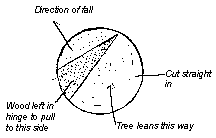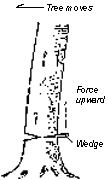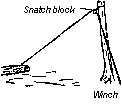|
Standards
A 15
B 1, 3
C 3
D 1, 3
|
|
Concepts
Leverage
Friction
Inertia
|
|
Without trees, life in most parts of Alaska would be impossible.
Areas that don’t have trees growing nearby rely on driftwood.
Knowing how to fall or, as we say, “knock” trees is an
important skill. Almost anyone can get a tree to fall over, but
it is difficult to log:
- safely,
- with the trees landing and pointing in the same direction,
and
- without getting hung up on other trees.
Instruction and experience help to develop the ability to log
safely.
Smaller trees can be pushed down fairly easily by hand or with
a long pole once the tree has been cut to the point of falling.
Larger trees, trees leaning in the wrong direction, and trees
that can get hung on surrounding trees, pose problems of their own.
Sometimes a logger may have all three problems at the same time.
Few trees grow straight up. Most have grown leaning toward the
sunlight, leaning from the wind, or leaning away from competing
trees in the area.
|
| |
Falling the Tree
- The first thing to determine when falling a tree is the direction
it is leaning. Is this the direction the logger wants it to go?
If the answer is “yes”, the process is easy.
- Clear the brush away from the trunk of the tree. There must
be room for the logger to work and to escape the falling tree.
- Cut a notch in the tree perpendicular to the direction the
tree is to fall.
The notch should be wide enough to allow the tree to lean over.
If the notch is too narrow, the tree will start to fall and then
hang on the notch.
If there is no notch in the front of the tree a terribly dangerous
situation exists, particularly if the tree is naturally leaning.
When it starts to fall, the trunk of the tree splits throwing
the logger and his saw quite a distance.
- From the back of the tree, cut in the direction the tree should
fall. If the tree is small it should be cut quickly so the inertia
of the tree will carry it to the ground past the clinging branches
of nearby trees and brush. If the tree goes down slowly, it will
often get hung up before reaching the ground, therefore creating
a troublesome or dangerous situation.
|
 Wide
notch Wide
notch
 Narrow
notch pinches Narrow
notch pinches
 No
notch No
notch
|

|
Hinge
 The
wood that is left between the notch and the back cut is called the
“hinge”. If the hinge is too thick, the tree will fall
slowly if at all. If the hinge is too thin, or cut completely through,
look out! The tree can fall in any direction. The bottom of the
tree can jump anywhere. It is a form of “widowmaker.”
(The logger’s wife can easily become a widow.) The
wood that is left between the notch and the back cut is called the
“hinge”. If the hinge is too thick, the tree will fall
slowly if at all. If the hinge is too thin, or cut completely through,
look out! The tree can fall in any direction. The bottom of the
tree can jump anywhere. It is a form of “widowmaker.”
(The logger’s wife can easily become a widow.)
If the tree is leaning in a different direction than desired,
the logger leaves more wood on one side of the hinge than the other.
As the tree starts to fall, the uneven hinge will actually pull
the tree in the direction the logger desires.
|
|


|
Wedges
As soon as the saw is deep enough into the back cut, the logger
puts a wedge or two in the cut behind the blade. If the tree leans
backward, this prevents the saw from pinching . Wedges can drive
even the biggest trees in the direction desired. One logger slowly
saws the tree while the helper, “swamper”, drives the
wedges.
Plastic wedges driven with a small axe work best because they
don’t split or dull the saw blade if hit by accident. Metal
wedges are out of the question for this reason. Plastic wedges are
cheap enough to be semi-disposable. Oldtimers used wooden wedges
made out of dry spruce or dry tamarack. (Green wood is too soft.)
Wooden wedges work as well as plastic, but tend to split after a
few uses. The awesome power of a wedge should never be underestimated.
A good logger drives the wedge, waiting until the tree top moves.
Then he cuts a little more before driving the wedge again. The logger
continues in this manner as it takes time for the tree top to move.
It might seem like a waste of time getting trees to fall in a
certain direction. When it is time to winch them out of the woods
or to cut them up into firewood, having an orderly wood yard or
logging operation saves immense amounts of time and frustration.
I used to make the back cut angled downward. This doesn’t
work with wedges, as they split the stump rather than driving and
lifting the tree in the desired direction.
Wind
When the wind is blowing in the direction the logger wants the
trees to fall, the job becomes easy. As the surface area of the
branches catch the wind, there is tremendous leverage from high
up on the tree. When a strong wind is against the logger, it might
be better to go home. Wind places enormous force on trees, making
logging unpredictable and dangerous. Live trees have fuller branches,
and are more strongly influenced by the wind than dead trees.
|
| |
Winter
In winter, frozen trees are more brittle than in warm weather.
They can snap and go down fast. There is less warning if things
aren’t going the way the logger plans. Often the snow around
the base of the tree makes escaping dangerous.
Many Alaskan logging operators prefer logging in March and April
as the trees are clean when they are skidded on the snow. Logs skidded
summertime are impossible to clean thoroughly. They dull the saw
blade quickly.
|

Peavey
|
 Hangups Hangups
Everyone who has logged has hung trees in the branches of nearby
trees. It happens. There is no safe solution. With a peavey, the
logger can use its leverage, rocking the base of the hung tree,
trying to get it to slide through the branches to the ground. This
works occasionally.
 It
is very dangerous to cut down the tree that is hanging up the first
one. I have gone home and returned after a wind storm, allowing
the wind to wrestle the dangerous tree to the ground rather than
risk freeing it myself. With a chainsaw winch, it is sometimes possible
to hook onto the tree that is hung and pull it sideways. (I ripped
a come-along apart one time trying to winch free a tree that was
hung.) It
is very dangerous to cut down the tree that is hanging up the first
one. I have gone home and returned after a wind storm, allowing
the wind to wrestle the dangerous tree to the ground rather than
risk freeing it myself. With a chainsaw winch, it is sometimes possible
to hook onto the tree that is hung and pull it sideways. (I ripped
a come-along apart one time trying to winch free a tree that was
hung.)
The most dangerous situation exists when a tree has fallen and
wedged itself between the trunks of two or three other trees. The
hidden pressure on the tree can throw the logger and his saw for
a long way when he cuts the tree free from its entanglement. (Experience
talking).
|
| |
Aftermath
While walking through a logging or wood yard, it is easy to see
if the loggers are experienced. Sometimes I am tempted to look for
dead bodies. Other times I can see that the logger was something
of an artist.
Oldtimers always cleaned up their wood yard when they were done,
often burning the branches. Nowadays, the Department of Natural
Resources asks people to cut all tree tops to two foot lengths and
to scatter branches. This allows them to dry quickly and prevents
spruce bark beetle infestation.
|
| |
Skidding Logs
 Green
logs are very heavy. I heard someone say, “Don’t think
how big a house you want, think how big a log you can handle.”
Nowadays we have power tools and chainsaw winches. With a chainsaw
winch and a snatch block (pulley) up in a tree to keep the front
of the log out of the dirt, and minimize friction, one person can
easily move forty foot logs. Green
logs are very heavy. I heard someone say, “Don’t think
how big a house you want, think how big a log you can handle.”
Nowadays we have power tools and chainsaw winches. With a chainsaw
winch and a snatch block (pulley) up in a tree to keep the front
of the log out of the dirt, and minimize friction, one person can
easily move forty foot logs.
 When
logging in late May to early July, oldtimers used to fall the tree,
limb it, and peel it, then skid the logs out of the woods on the
smooth bark. Sometimes they lined up the bark from several trees
like a trail to the riverbank. The slippery logs are easy to move
on the equally slippery inner bark that was just removed from the
trees. Friction is at a minimum. When
logging in late May to early July, oldtimers used to fall the tree,
limb it, and peel it, then skid the logs out of the woods on the
smooth bark. Sometimes they lined up the bark from several trees
like a trail to the riverbank. The slippery logs are easy to move
on the equally slippery inner bark that was just removed from the
trees. Friction is at a minimum.
Before chainsaw winches were available, we often cut a spruce
tree about six inches in diameter in three foot lengths. We peeled
them, and split them in half. Laying them on the ground with the
round, smooth side up, we skidded the logs out of the woods on top
of them. Overcoming friction is the total objective. The surface
of the freshly peeled spruce in May and July is like using the best
grease available. This is a common way to get logs for fishwheels
or fish cutting rafts.
When all logging is done by hand, it is very important to have
logs pointing in the right direction. They are heavy to turn or
move.
|
| |
Methods of Old
 To
get peeled logs up the bank from a raft, we first winched the smallest
of them bottom (butt) side up. Then we placed two of them side by
side, and held them together with stakes driven in the ground. We
used this as a trough to winch the next two logs up the bank, once
again butt first. We staked them out like the first ones, and continued
until there was a trough all the way to the house site. We then
winched the logs up the bank on the slippery surface of the peeled
logs below. When all the logs were out of the water and in place
in the house, we winched the bottom logs up, proceeding all the
way to the top. This was another friction reducing technique that
kept the logs clean. Dirty logs dull tools quickly. To
get peeled logs up the bank from a raft, we first winched the smallest
of them bottom (butt) side up. Then we placed two of them side by
side, and held them together with stakes driven in the ground. We
used this as a trough to winch the next two logs up the bank, once
again butt first. We staked them out like the first ones, and continued
until there was a trough all the way to the house site. We then
winched the logs up the bank on the slippery surface of the peeled
logs below. When all the logs were out of the water and in place
in the house, we winched the bottom logs up, proceeding all the
way to the top. This was another friction reducing technique that
kept the logs clean. Dirty logs dull tools quickly.
|

|
Activities
- Cut a small tree. Have a person push the tree with a pole held
ten to twelve feet up the trunk. Does the pole help to push the
tree over with enough inertia that it doesn’t get hung up?
- Purchase a couple of plastic wedges. Use them to tip trees
that are leaning the wrong way. Make wooden wedges out of dry
wood. Compare the results. One person should run the saw and another
person drive the wedges.
-
 Before
falling a tree, stand back and hang an axe head down from your
hand at arm’s length. It will hang straight down according
to gravity. Line the axe handle in your sight against the tree.
Can you see any leaning of the tree? Does this help determine
how you fall the tree? Some people say this isn’t worth doing
on flat ground, but helps greatly on a slight hillside. What do
you think? Before
falling a tree, stand back and hang an axe head down from your
hand at arm’s length. It will hang straight down according
to gravity. Line the axe handle in your sight against the tree.
Can you see any leaning of the tree? Does this help determine
how you fall the tree? Some people say this isn’t worth doing
on flat ground, but helps greatly on a slight hillside. What do
you think?
- Ask local people how they release trees that are hung up.
- Have a contest. Let several people put a stick in the ground
twenty-five feet away from a tree. See who can fall their tree
the closest to the stake. Make good use of the trees.
- Ask local people if they can tell the difference between falling
trees in summer and winter. Do they snap more noticeably in the
winter?
- Ask local people what happens if you fall a tree and don’t
first make a notch in the front of the tree. Do their comments
agree with the above text?
- Try skidding a log on the ground. Put skids underneath as described
in the text above. What are the differences?
- Ask the oldtimers in the village if there are any pictures
of the old winches that were used to pull logs up the bank.
Ask them how they skidded the logs. Did any of them do it in the
manner described in the above text?
|

|
Student Response
- Draw a tree will fall to the right.
- Why would a living tree be more effected by the wind than a
dead one?
- Draw what will happen if there is no notch in the front of
the tree.
- Draw what will happen if the notch on the front of the tree
is not V cut, but only as wide as the saw blade.
- Draw the top view of the stump of a tree that was made to pull
to the left.
- Why is it dangerous to completely cut the hinge when falling
a tree?
- Why is falling trees more dangerous in the winter than in the
summer?
- Why does the logger want the tree to fall fast once it starts
to go down?
- When skidding logs out of the woods, what is the most important
thing to avoid? Name one technique for doing this.
- From the whole lesson, list four things that are dangerous
when logging.
|

|
Math
- Matt can fall and limb 25 trees a day. He can cut an average
of 36’ of 6” x 6” house logs from each tree. His
house is going to be 24’ x 32’ with 8’ high walls
(each linear foot of house log z .5 square foot). Approximately
how many days must he log in order to get enough logs to make
his house out of three-sided logs?
- Matt is done with his house. He figures that he needs 5 cords
of wood to get through the winter. A cord of wood is 4’ x
4’ x 8’. He can cut and split approximately 100 cubic
feet of wood a day. How long will it take him to cut and split
enough wood for all winter?
- Harold can fall and raft 100 logs in 7 days. Two men can do
the same job in 3 days. He has to take time off his job making
$100 a day to do this. He can pay his nephew $80 a day to help
him. Which is cheaper for Harold: to work alone or hire help?
|
|






 Wide
notch
Wide
notch No
notch
No
notch The
wood that is left between the notch and the back cut is called the
“hinge”. If the hinge is too thick, the tree will fall
slowly if at all. If the hinge is too thin, or cut completely through,
look out! The tree can fall in any direction. The bottom of the
tree can jump anywhere. It is a form of “widowmaker.”
(The logger’s wife can easily become a widow.)
The
wood that is left between the notch and the back cut is called the
“hinge”. If the hinge is too thick, the tree will fall
slowly if at all. If the hinge is too thin, or cut completely through,
look out! The tree can fall in any direction. The bottom of the
tree can jump anywhere. It is a form of “widowmaker.”
(The logger’s wife can easily become a widow.)


 It
is very dangerous to cut down the tree that is hanging up the first
one. I have gone home and returned after a wind storm, allowing
the wind to wrestle the dangerous tree to the ground rather than
risk freeing it myself. With a chainsaw winch, it is sometimes possible
to hook onto the tree that is hung and pull it sideways. (I ripped
a come-along apart one time trying to winch free a tree that was
hung.)
It
is very dangerous to cut down the tree that is hanging up the first
one. I have gone home and returned after a wind storm, allowing
the wind to wrestle the dangerous tree to the ground rather than
risk freeing it myself. With a chainsaw winch, it is sometimes possible
to hook onto the tree that is hung and pull it sideways. (I ripped
a come-along apart one time trying to winch free a tree that was
hung.)
 Green
logs are very heavy. I heard someone say, “Don’t think
how big a house you want, think how big a log you can handle.”
Nowadays we have power tools and chainsaw winches. With a chainsaw
winch and a snatch block (pulley) up in a tree to keep the front
of the log out of the dirt, and minimize friction, one person can
easily move forty foot logs.
Green
logs are very heavy. I heard someone say, “Don’t think
how big a house you want, think how big a log you can handle.”
Nowadays we have power tools and chainsaw winches. With a chainsaw
winch and a snatch block (pulley) up in a tree to keep the front
of the log out of the dirt, and minimize friction, one person can
easily move forty foot logs.
 When
logging in late May to early July, oldtimers used to fall the tree,
limb it, and peel it, then skid the logs out of the woods on the
smooth bark. Sometimes they lined up the bark from several trees
like a trail to the riverbank. The slippery logs are easy to move
on the equally slippery inner bark that was just removed from the
trees. Friction is at a minimum.
When
logging in late May to early July, oldtimers used to fall the tree,
limb it, and peel it, then skid the logs out of the woods on the
smooth bark. Sometimes they lined up the bark from several trees
like a trail to the riverbank. The slippery logs are easy to move
on the equally slippery inner bark that was just removed from the
trees. Friction is at a minimum.
 To
get peeled logs up the bank from a raft, we first winched the smallest
of them bottom (butt) side up. Then we placed two of them side by
side, and held them together with stakes driven in the ground. We
used this as a trough to winch the next two logs up the bank, once
again butt first. We staked them out like the first ones, and continued
until there was a trough all the way to the house site. We then
winched the logs up the bank on the slippery surface of the peeled
logs below. When all the logs were out of the water and in place
in the house, we winched the bottom logs up, proceeding all the
way to the top. This was another friction reducing technique that
kept the logs clean. Dirty logs dull tools quickly.
To
get peeled logs up the bank from a raft, we first winched the smallest
of them bottom (butt) side up. Then we placed two of them side by
side, and held them together with stakes driven in the ground. We
used this as a trough to winch the next two logs up the bank, once
again butt first. We staked them out like the first ones, and continued
until there was a trough all the way to the house site. We then
winched the logs up the bank on the slippery surface of the peeled
logs below. When all the logs were out of the water and in place
in the house, we winched the bottom logs up, proceeding all the
way to the top. This was another friction reducing technique that
kept the logs clean. Dirty logs dull tools quickly.
 Before
falling a tree, stand back and hang an axe head down from your
hand at arm’s length. It will hang straight down according
to gravity. Line the axe handle in your sight against the tree.
Can you see any leaning of the tree? Does this help determine
how you fall the tree? Some people say this isn’t worth doing
on flat ground, but helps greatly on a slight hillside. What do
you think?
Before
falling a tree, stand back and hang an axe head down from your
hand at arm’s length. It will hang straight down according
to gravity. Line the axe handle in your sight against the tree.
Can you see any leaning of the tree? Does this help determine
how you fall the tree? Some people say this isn’t worth doing
on flat ground, but helps greatly on a slight hillside. What do
you think?